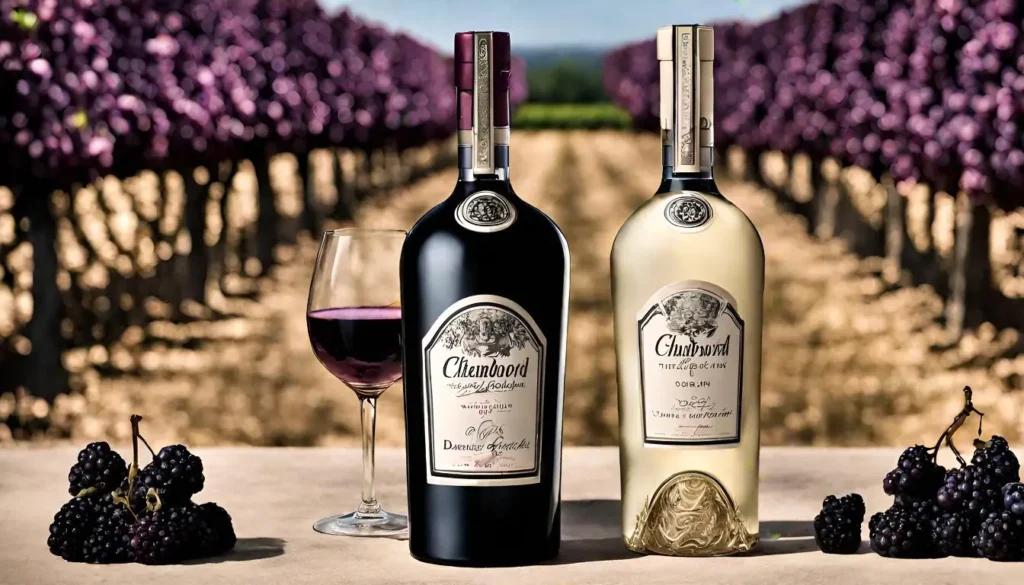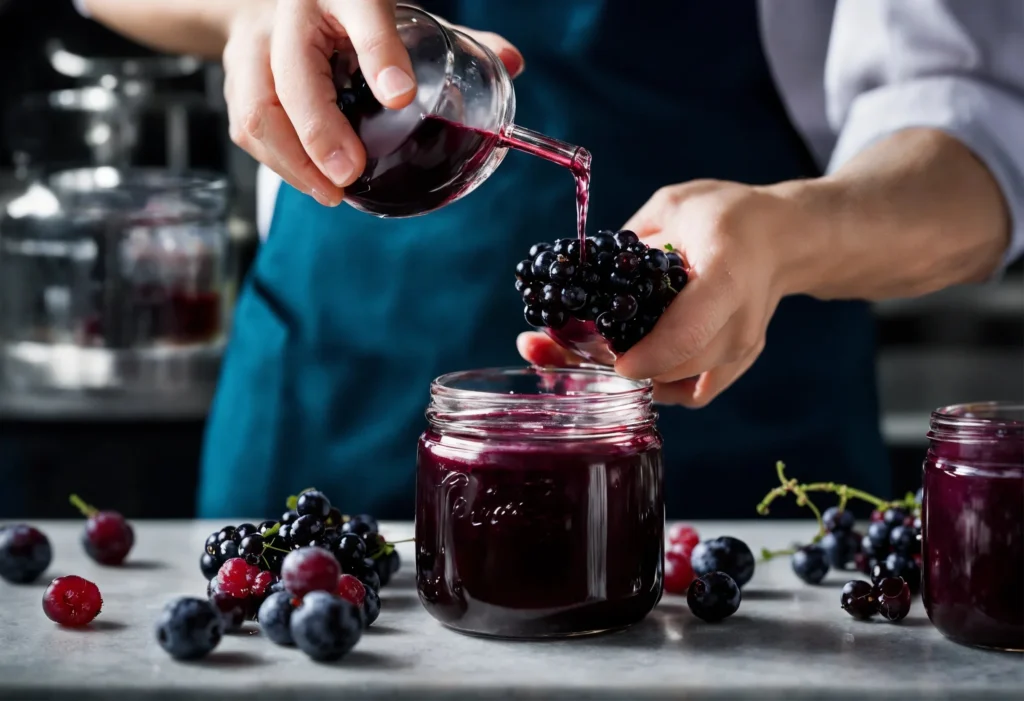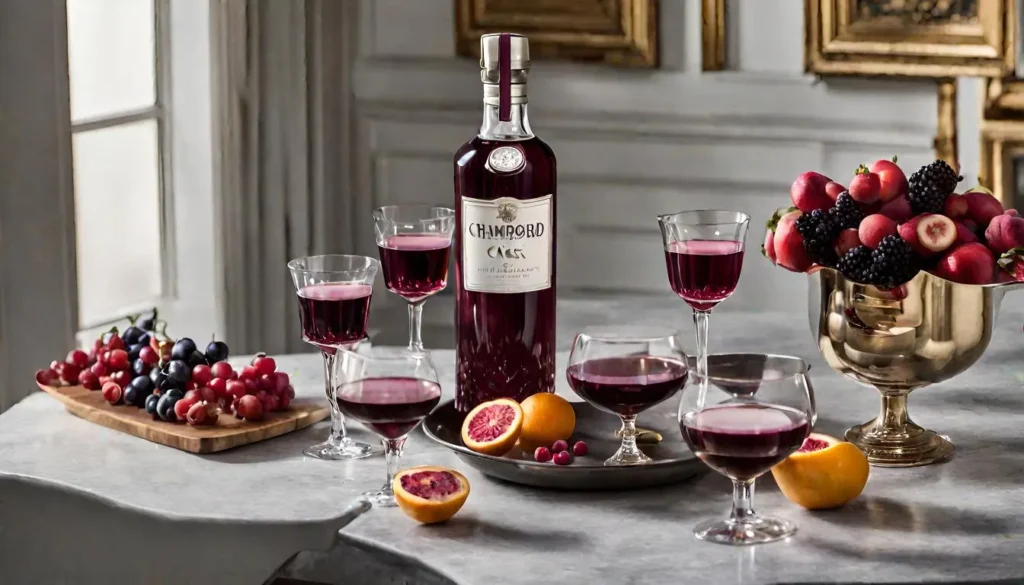In this comprehensive exploration, we delve into the intriguing world of two renowned liqueurs: Crème de Cassis and Chambord. Often mistaken for one another, these spirits boast unique histories, flavors, and uses that set them apart. From their monastic origins to their royal connections, and from classic cocktails to modern culinary applications. We unravel the mysteries of these exquisite French creations. Join us on this flavorful journey as we compare, contrast, and celebrate the distinct characteristics of Crème de Cassis and Chambord.
Introduction to Crème de Cassis and Chambord
Exploring Crème de Cassis and Chambord: Are They the Same?
Ah, the age-old question in the world of liqueurs: Is Crème de Cassis the same as Chambord? While both hail from the picturesque landscapes of France and share a certain fruity charm. They are, in fact, distinct in their own right.
Crème de Cassis, a velvety concoction. Is primarily made from blackcurrants, and its history, uses, and trends are as rich as its flavor. This liqueur is known for its deep, almost mystical purple hue and a flavor profile that dances between sweet and tart. It’s a classic ingredient in many cocktails and adds a touch of elegance to various desserts.
On the other hand, Chambord whispers tales of luxury and sophistication. Crafted with black raspberries, this liqueur is a blend of rich flavors, including Madagascan vanilla and Moroccan citrus peel. Creating a symphony of sweetness with subtle floral undertones. Its iconic bottle, reminiscent of the French Renaissance, is a testament to its royal lineage and exquisite craftsmanship. For more on the elegance of French liqueurs, visit Food & Wine.

As we embark on this journey, we’ll explore the nuances that make each of these liqueurs a standalone masterpiece. From their storied histories to their complex flavor profiles, and their revered status in the world of mixology and gastronomy. There’s much to uncover about Crème de Cassis and Chambord. So, let’s raise our glasses to a voyage of discovery into the heart of these beloved French spirits.
Tracing the Origins: Crème de Cassis vs Chambord
Origin and History of Crème de Cassis and Chambord
Diving into the past, the histories of Crème de Cassis and Chambord are as rich and intriguing as their flavors. These liqueurs are not just alcoholic beverages; they are a journey through time, embodying the essence of their origins.

The Monastic Beginnings of Crème de Cassis
Crème de Cassis has its roots deeply embedded in the monastic traditions of France. Originating in the 16th century, this luscious liqueur was first concocted by French monks in the Burgundy region. The monks, known for their expertise in herbal remedies and liqueur creation, discovered the unique properties of blackcurrants. Which you can learn more about in our article on the flavor of Crème de Cassis. and began experimenting with them. They macerated the berries in alcohol, creating a sweet, rich elixir that quickly gained popularity. This traditional method of production, passed down through generations, has remained largely unchanged, preserving the authentic taste of Crème de Cassis.
Chambord’s Royal Heritage
Chambord, on the other hand, boasts a regal history. It dates back to the late 17th century in the Loire Valley, a region renowned for its castles and vineyards. Legend has it that Chambord was created at the behest of King Louis XIV. The king desired a unique liqueur that could capture the essence of luxury and elegance. His alchemists blended raspberries with blackberries, Madagascan vanilla, Moroccan citrus peels, and other exotic ingredients to create a liqueur fit for royalty. The distinctive bottle, resembling a royal orb, further cements Chambord‘s status as a drink of nobility.
The contrasting histories of these two liqueurs are a testament to their enduring legacy. While Crème de Cassis finds its charm in monastic simplicity and traditionalism, Chambord revels in the opulence and grandeur of the French court. Discover more about the rich history of French cuisine and its influence on liqueurs at Bon Appétit.
Ingredients of Distinction: Crème de Cassis and Chambord Compared
Ingredients and Production Methods
The distinctiveness of Crème de Cassis and Chambord extends beyond their historical narratives to their unique ingredients and meticulous production processes. These elements are pivotal in shaping the character and flavor profiles of each liqueur.

Crème de Cassis: Blackcurrants and Traditional Methods
The soul of Crème de Cassis lies in the blackcurrant, a fruit known for its deep, tart flavor and rich color. Originating from the fertile soils of Burgundy, these berries are the cornerstone of the liqueur’s production. The traditional method involves macerating the ripe blackcurrants in alcohol, a process detailed in our exploration of whether Crème de Cassis is alcoholic. Allowing the fruit’s natural flavors and colors to infuse into the spirit. This process, coupled with the addition of sugar, results in a liqueur that is both sweet and tangy, with a velvety texture that is unmistakably Crème de Cassis. The adherence to these age-old techniques ensures that each bottle captures the essence of the blackcurrant in its purest form.
Chambord: Raspberry Blend and Unique Ingredients
Chambord, in contrast, is a symphony of multiple ingredients, each playing a vital role in its composition. The primary ingredient is the black raspberry, sourced from the fields of France. These raspberries, along with blackberries, are steeped in French spirits for several weeks. This infusion is then blended with a concoction of other natural ingredients, including Madagascan vanilla, Moroccan citrus peels, honey, and cognac. This intricate process creates a liqueur that is complex, with a balance of sweet, tart, and floral notes. The production of Chambord is a delicate art, ensuring that each bottle is a representation of luxury and refinement.
The ingredients and production methods of Crème de Cassis and Chambord are a reflection of their distinct identities. While Crème de Cassis is a celebration of the singular beauty of blackcurrants, Chambord is an elaborate tapestry of flavors and aromas. Both liqueurs, through their unique creation processes, offer a glimpse into the rich tapestry of French liqueur-making tradition. For a deeper dive into the world of liqueurs and their ingredients, check out Liquor.com.
Tasting Notes: The Unique Flavors of Crème de Cassis and Chambord
Analyzing the Flavor Profiles
The allure of Crème de Cassis and Chambord is not just in their storied pasts or their meticulous crafting but also in their distinctive and captivating flavor profiles. Each offers a unique taste experience that sets them apart in the world of liqueurs.

The Richness of Crème de Cassis
Crème de Cassis is celebrated for its deep, resonant flavor that is both bold and nuanced. The essence of blackcurrants imparts a rich fruitiness, characterized by a perfect harmony of sweetness and tartness. This liqueur has a full-bodied taste, with the natural acidity of the berries cutting through the sweetness. Creating a complex and layered drinking experience. The robust flavor of Crème de Cassis makes it not only a delightful sipper. But if you’re looking for alternatives, consider exploring substitutes for Crème de Cassis. But also a versatile mixer, adding depth and character to cocktails and culinary creations alike.
The Delicate Sweetness of Chambord
Chambord, in contrast, is a more subtle and intricate affair. The primary notes of black raspberry are complemented by the gentle sweetness of honey and the exotic richness of vanilla. This combination, along with the added citrus peels and cognac, creates a liqueur that is both elegant and complex. The flavor profile of Chambord is lighter and more floral compared to Crème de Cassis. With a refined sweetness that makes it a favorite for adding a touch of sophistication to cocktails and desserts.
The flavor profiles of Crème de Cassis and Chambord are a testament to the art of liqueur making. While Crème de Cassis offers a bold and straightforward expression of blackcurrants, Chambord presents a more layered and nuanced flavor journey. Explore a variety of flavor profiles in liqueurs and their culinary applications at Food & Wine.
Cocktail Creations: Utilizing Crème de Cassis and Chambord
Culinary and Mixology Applications
The versatility of Crème de Cassis and Chambord extends beyond their delightful tastes to their wide-ranging applications in both cocktails and culinary dishes. These liqueurs not only add unique flavors but also bring an element of sophistication to various creations.
Crème de Cassis in Classic Cocktails and Desserts
Crème de Cassis has long been a staple in the world of mixology. Its most famous use is in the Kir cocktail, where it is mixed with white wine, and in the Kir Royale. Its variant with champagne. The liqueur’s rich, fruity flavor and deep purple color make it an excellent addition to these classic drinks. Providing a perfect balance to the acidity of the wine or the effervescence of the champagne. Beyond cocktails, Crème de Cassis also finds its way into the culinary world. Its sweet and tart profile makes it an ideal ingredient for flavoring desserts like sorbets, tarts, and fruit salads, adding a touch of elegance and a burst of berry flavor.
Chambord’s Versatility in Modern Drinks and Dishes
Chambord, with its luxurious blend of raspberries, blackberries, vanilla, and cognac, is a favorite among contemporary mixologists, much like the ingredients used in the Scooby Snack Shot. It’s a key ingredient in the French Martini, lending the drink a smooth, fruity sophistication. Additionally, Chambord is used in creating innovative cocktails, adding complexity and a hint of sweetness. In the realm of gastronomy, Chambord enhances the flavor profile of various desserts, such as chocolate mousse or cheesecakes, and can even be drizzled over ice cream for a decadent treat. Its versatility also extends to savory dishes, where it can be used in sauces to accompany meats, adding a unique twist to traditional recipes.
The use of Crème de Cassis and Chambord in cocktails and cuisine showcases their adaptability and appeal. Whether it’s adding depth to a classic cocktail or a burst of flavor to a gourmet dish, these liqueurs elevate the ordinary to the extraordinary. For innovative cocktail recipes using these liqueurs, visit Liquor.com.
Comparison and Contrasts
Direct Comparison: Crème de Cassis vs. Chambord
While Crème de Cassis and Chambord share a common ground as fruit-based French liqueurs, their distinct characteristics set them apart in the world of spirits. Understanding these differences is key to appreciating each for its unique qualities and making informed choices in their use.
Similarities and Differences
At first glance, Crème de Cassis and Chambord might seem similar with their fruit-based compositions and French origins. However, the primary difference lies in their main ingredients. Crème de Cassis is made from blackcurrants, offering a bold, tart, and sweet flavor, while Chambord is crafted from black raspberries, along with a blend of other berries, vanilla, and cognac, resulting in a more complex, sweet, and subtly floral profile.
The production methods also differ. Crème de Cassis follows a simpler, more traditional process focusing on the purity of the blackcurrant flavor. In contrast, Chambord‘s production is more intricate, blending various ingredients to achieve its unique taste.
In terms of color, Crème de Cassis is known for its deep, dark purple hue, whereas Chambord possesses a more refined, lighter color, reflecting its delicate flavor profile.
Choosing Between the Two
When it comes to selecting between Crème de Cassis and Chambord, it boils down to personal preference and the desired outcome in a cocktail or culinary creation. If a recipe calls for a bold, fruity flavor with a balance of sweetness and tartness, Crème de Cassis is the ideal choice. Its robust profile makes it perfect for drinks and dishes that can handle, or require, a stronger fruit presence.
Conversely, if the goal is to add a touch of elegance and a complex, sweet flavor with floral undertones, Chambord is the go-to liqueur. Its versatility and subtle sweetness make it suitable for more delicate cocktails and desserts.
In conclusion, while Crème de Cassis and Chambord may be similar in some aspects. Their differences in flavor, ingredients, and production methods set them apart. Each has its unique place in the world of liqueurs, capable of transforming a simple drink or dish into something truly extraordinary. For creative culinary ideas using these liqueurs, head over to Bon Appétit.
Frequently Asked Questions
1. Best Cocktails with Crème de Cassis and Chambord
For Crème de Cassis, classics like the Kir and Kir Royale are popular choices. Its robust flavor also enhances fruity cocktails. Chambord, with its delicate sweetness, is perfect for a French Martini or a Chambord Spritz, adding elegance to these drinks.
2. Non-Alcoholic Recipes with Crème de Cassis and Chambord
Absolutely! Both liqueurs can flavor desserts like mousses, tarts, and ice creams. They’re also great for elevating mocktails or fruit punches.
3. Storage Recommendations
Store both in a cool, dark place. While not requiring refrigeration, keeping them away from direct sunlight and heat preserves their flavors.
4. Dietary Considerations
Both contain alcohol and sugars, so individuals with dietary restrictions should check for allergens or specific ingredients based on their needs.
5. Interchangeability in Recipes
While they can be substituted, it’s crucial to consider their distinct flavor profiles. Crème de Cassis provides a stronger berry flavor, while Chambord adds a more subtle, sweet, and complex taste.
6. Shelf Life Guidelines
Generally, due to their alcohol content, these liqueurs have a long shelf life. However, for optimal flavor, it’s recommended to consume them within a few years of opening.
7. Food Pairing Recommendations
Crème de Cassis complements creamy desserts and sharp cheeses. Chambord pairs well with chocolate desserts and fruit-based dishes, enhancing their flavors.
Addressing these FAQs helps in not only understanding Crème de Cassis and Chambord better but also in appreciating the versatility and richness they bring to both the culinary and cocktail worlds. For more FAQs on French liqueurs, visit Food & Wine.
Conclusion
Final Thoughts and Recommendations
As we conclude our exploration of Crème de Cassis and Chambord, it’s clear that these two exquisite liqueurs offer much more than just their delightful tastes. They are a blend of history, tradition, and craftsmanship. Each telling its own unique story through its flavor profile and usage.
Crème de Cassis, with its deep roots in monastic tradition and its bold, fruity essence, stands out as a testament to the simplicity and purity of blackcurrants. It’s a versatile choice for those who appreciate a stronger, more pronounced berry flavor in their cocktails and culinary endeavors.
Chambord, on the other hand, is a symbol of luxury and sophistication. Its complex blend of raspberries, blackberries, vanilla, and cognac offers a more nuanced and delicate flavor profile. It’s perfect for adding a touch of elegance and subtlety to drinks and dishes.
Both liqueurs, with their distinct characteristics, have earned their place in the world of fine spirits. Whether you’re a mixologist crafting the next signature cocktail, a chef experimenting with flavors, or simply someone who enjoys the finer things in life. Crème de Cassis and Chambord offer endless possibilities to enhance your creations.
In the end, the choice between Crème de Cassis and Chambord depends on personal preference and the specific requirements of the recipe at hand. But one thing is certain: whichever you choose, you’re in for a treat that’s rich in flavor and history. So, here’s to the joy of discovery and the pleasure of tasting – cheers to Crème de Cassis and Chambord!
Crème de Cassis and Chambord Comparison
Ingredients
Method
- Delve into the unique histories and flavors of Crème de Cassis and Chambord.
- Taste both liqueurs separately to appreciate their distinct profiles.
- Experiment with both in cocktails such as Kir and French Martini.
- Consider using Crème de Cassis in desserts and Chambord for a sophisticated touch in cocktails.




